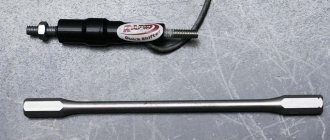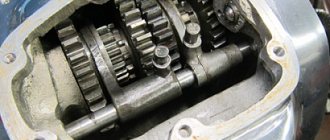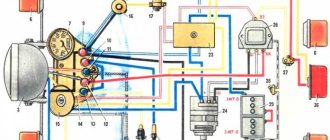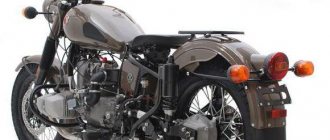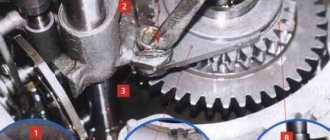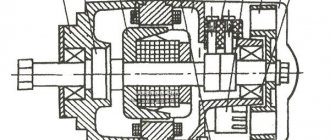How to identify engine problems based on the condition of the spark plug?
In order to determine engine problems based on the condition of the spark plug, you need to properly prepare it. And so, start the moped engine and ride it at a speed of 40-50 km/h. You need to drive about 10 km. When you arrive, turn off the engine, be sure to let it cool, and only after it has cooled do you unscrew the spark plug. Another thing that needs to be clarified is that as soon as you stop, immediately turn off the engine; if you let the engine idle while stopping, then you will have to drive 10 km again.
- The color of a candle is determined only by the central part of the candle itself. Let's look at the picture. This candle has the correct brown color, but the other side is almost white. This means that the mixture does not ignite evenly in the cylinder. Because of this, it may happen that 1 part of the candle is white and the other is brown. In this case, the engine runs a little lean. It's not scary - it's within the normal range. In this mode you will get slightly less fuel consumption, but also less engine power.
- On the next candle we also see carbon deposits and the insulator is also black, but on the other side it is brown. This means that the engine runs on a slightly rich mixture. This is good because you will get a little more power, but the bad thing is that you will have a little higher fuel consumption. But this is also the norm. The engine is running normally.
- We look at the picture, as we see there is practically no black soot on this candle, the insulator is slightly brown, and the other sides are white. This means that the engine is running on a lean mixture - this can cause both engine overheating and improper combustion of the mixture and increased fuel consumption. This kind of candle is no longer the norm. Also, if the mixture is too lean, you will see white deposits on the spark plug (they are difficult to notice), which means your engine is running on a too lean mixture and you need to urgently adjust the carburetor.
- This spark plug shows that the engine was running on a very rich mixture. The entire candle is black. This immediately means increased fuel consumption and slightly less engine power. If you see such a spark plug, you definitely need to adjust the carburetor. Also look inside the spark plug, if you see oil deposits there, this should not be the case. This means that you need to change the rings or valve stem seals. (oil has the right to appear only on the thread).
- If you see metal dust on the spark plug, this means that your engine has begun to deteriorate. Either you were driving at too high speeds or the mixture was lean for too long. If you see, through a magnifying glass or without it, marking points on the spark plug and so on, then you may soon have to change the engine, or rather the CPG. The dots should be shiny.
- If the edge of the spark plug is slightly rounded, this means that erosive wear has begun. Those. the candle worked for so long that metal particles simply began to evaporate from it. The same thing can be found on the electrode of the spark plug; if you see that the spark has made a groove, then everything is fine with the engine, but you just need to change the spark plug. If you see a crack on the insulator, you need to change the spark plug immediately. And if the insulator completely shatters, then disassemble the CPG immediately, because fragments of the spark plug got into the cylinder and could scratch the walls, valves, and rings there.
How to identify engine problems based on the condition of the spark plug? Link to main publication
moped-info.ru
"Jerking in the motorcycle transmission"
First case
When accelerating a motorcycle in all gears, but primarily in lower gears, jerks occur, accompanied by a characteristic crackling sound in the engine or in the rear chain drive (the second is much more common). Apparently the motor or rear chains are very worn. If we are talking about a motor one, then you cannot do without replacing it (with simultaneous replacement of the drive sprocket, and sometimes the clutch drum), because this mechanism does not have any adjusting elements.
The rear chain drive is adjustable. If the target has not yet become unusable, but is simply loosely tensioned, it is enough to tighten it accordingly. But don’t rush to grab the keys, think for a minute. Most often, it is no coincidence that the chain jumps over the sprocket teeth not along its entire length, but in some section. The reason is usually that it wears unevenly (see picture), sometimes extremely unevenly. Some links are preserved better, others worse, and if the chain is old, you can often see bushings with through wear on the walls, half-worn pins, areas without rollers, etc. Of course, such a chain is changed when a new one is at hand. What does a motorcycle tourist do when he discovers (to his shame!) such a chain a thousand kilometers from home?
Here, as experience shows, you can do this. First of all, care is taken to ensure that the chain can work more evenly, without much jerking. This means that there should be no significant difference between heavily worn and lightly worn areas. How to do it? The chain is removed and, with patience, methodically re-riveted, trying to assemble the links in such a way that good fingers fit into the heavily worn bushings and vice versa. The work is painstaking, but it makes it possible to ensure that the chain no longer breaks the sprocket teeth in some part while moving. Further, if some of the rollers are missing, they try to distribute these “holes” more evenly, so that there are not two or more next to each other, otherwise the neighboring rollers will begin to split in this place from overload. If all this is not done, in many cases it will not be possible to tension the chain more or less acceptable - in some place it will be weakened to the limit, and in another it will be so tight that it can burst at full travel of the wheel suspension.
Black candle on a scooter
If for some reason you are not satisfied with the operation of the scooter engine and you decide to check the spark plug. We unscrewed it, and it had a black, velvety soot. What to do? Why could this happen?
There may be several answers to this question. First, you need to check that the carburetor is set correctly. Basically, the reason lies precisely in it. Black carbon deposits are caused by the fuel mixture being too rich. The richness of the mixture can be adjusted using a special screw - the mixture quality adjustment screw. In this case, it must be screwed in a quarter or half a turn. You can also experiment with the needle - try lowering it one notch.
Another reason for a rich mixture could be a dirty air filter. In this case, you need to clean it or buy a new one.
Read also: why does the carburetor on a scooter overflow?
If the deposit is oily, then it is quite possible that oil is getting into the combustion chamber. In this case, it is best to check the suitability of the piston rings.
If you do everything as indicated above, then the black soot from the candle should disappear.
auto-myinfo.ru
Interruptions and jerks in the motorcycle robot: what to do
Probably, every motorcyclist has encountered unpleasant cases when the engine suddenly starts running intermittently or jerks appear in the transmission, the cause of which can be determined after a long search, and sometimes after dismantling half the machine in vain. Only after accumulating knowledge and experience can they find and eliminate such faults without wasting time.
If one day you notice some unusual feature in the behavior of a machine that has long been familiar to you, first of all, determine in what operating mode this occurs. Take a closer look, observe and don’t rush to conclusions. The fact is that externally identical defects can be caused by many completely different, sometimes unrelated, reasons. Let's look at specific examples given by readers.
Checking spark plugs, mixture quality by insulator color
When servicing a scooter, it is necessary to unscrew the scooter's spark plug to determine whether the carburetor is set correctly. It is important to pay attention to the brand and heat rating of the spark plug - if you install a spark plug with a different heat rating from the recommended one, it will not self-clean. If the candle is whitish, you need to enrich the mixture; if it is black, lean it. The adjustment is made on the scooter's carburetor with a special screw located under the cover covering the accelerator drive rocker arm. It is important to remember that a scooter air filter clogged with dirt, without passing the required amount of air, will cause the mixture to become richer, and before drawing conclusions about the need to adjust the scooter carburetor, it is necessary to check the condition of the air filter. A correctly selected scooter spark plug has a decisive influence on the performance of the scooter, as well as on its temperature regime. A spark plug with the heat rating recommended by the manufacturer should be installed on the engine only; only in this case will the process of self-cleaning from carbon deposits occur.
The spark plug is a comprehensive source of information for deciding on the necessary repair procedures.
It must be remembered that the reason for the enrichment of the scooter mixture can be not only incorrect carburetor settings, but also a dirty scooter air filter; and the cause of a lean mixture may be the scooter’s fuel system clogged with dirt.
Normal look. Type of spark plug: light gray to brown with slight sediment, as well as slight electrode erosion.
Conclusion: the scooter engine is in normal condition, the air-fuel mixture and ignition are adjusted correctly; the glow number of the candle is selected correctly; there are no ignition interruptions;
Soot contamination Type of spark plug: dry soft carbon deposits of intense black color on the insulator, electrodes and spark plug body.
Consequences: poor start of the scooter engine; poor operation of a cold scooter engine; interruptions in ignition of the air-fuel mixture; bad reaction to gas.
Probable causes: excessively rich air-fuel mixture; The scooter's air filter is very clogged; The thermal range is incorrectly selected - the candle is too “cold”.
Remedy: adjust the working mixture; adjust the cold start system of the scooter engine; change the scooter air filter; clean the spark plugs or replace them with new ones - with the correct heat rating.
Overheat. Plug Type: Extremely white insulator with small black flecks and premature electrode erosion.
Consequences: loss of scooter power at high speed or under load.
Probable causes: the spark plug is not screwed in enough; The scooter's engine cooling system is not working properly; ignition of the scooter too early; The thermal range is incorrectly selected - the candle is too “hot”.
Remedy: check the torque of the scooter's spark plug; operation of the scooter engine cooling system; adjust the ignition timing; select the correct spark plug heat rating.
Checking the spark plug Type of spark plug: melted and burned central and grounding electrodes (or one of the electrodes) of the scooter spark plug; bubbling insulator with metal deposits on it.
Consequences: significant loss of scooter engine power; ignition interruptions. Continued use of such spark plugs may cause serious damage to the scooter engine.
Probable causes: thermal overload; significant overheating of spark plug parts due to glow ignition - combustion begins before a proper ignition spark appears; use of low-quality fuel; burning out of the remaining air-fuel mixture in the combustion chamber due to an incorrectly adjusted fuel system of the scooter or the ignition timing of the scooter; The thermal range is incorrectly selected - the spark plug is too “hot”.
Remedy: check the scooter engine, ignition system and fuel system, as well as the quality of the working mixture and the ignition timing of the scooter. Install new spark plugs with the correct heat rating.
Oil contamination of the spark plug: wet oily black deposits on the insulator, black oil deposits on the insulator, electrodes and spark plug body.
Consequences: poor start of the scooter engine, interruptions in ignition.
Probable causes: too much oil in the fuel mixture (for two-stroke engines); wear of the rings and/or piston liner - wastes oil.
Remedy: mix gasoline and oil in the correct proportion, install new spark plugs for the scooter (for two-stroke engines); inspect the condition of the scooter engine, if necessary, repair the engine, CPG;
scooter.pp.ua
Interruptions and jerking in the motorcycle robot: what to do: 3 comments
please tell me, I have a Honda Varadero 1000 carb. It starts up great! drives around the city without any complaints! but as soon as you accelerate on the highway, somewhere after 5 rpm of 140 km per hour, interruptions occur in the engine (it slows down) and the power is lost! But at the same time the speed slowly picks up beyond 200! .as soon as you stop revving the gas and enter the city everything is smooth and clear. Please tell me what is the reason, where to start?
Why is my front brake pad wire twitching and why is the second one twitching too?
Ural fires one cylinder.
#1 Fighting Cat
- Spotted here
- 17 messages
- City: B. Glushitsa
- Technique: IZHYU5; Ural 2; IMZ 8.103
Good day. Tell me, has anyone encountered this, Ural engine. M-67, the right cylinder shoots into the air. The ignition was set to TDC by the light bulb, the valves were adjusted both at TDC and as written in the book, the camshaft was changed, nothing changed, the valves were checked for leaks, everything is holding perfectly, the explosive wires were swapped in places without any difference, it shoots and does not develop speed, the carburetors were changed, they were installed from a working motorcycle no changes, the ignition was changed many times, the capacitors were changed to no avail, the ignition coils were set to different 6V and 12V, the spark plugs were changed and it still doesn’t work. I am not the first owner of the motorcycle, and it seems that it once had capital, and perhaps the number changed. Could it be that the shaft is such that the newer crankshafts (which are sold in the store) have a different space for the key than the number of shafts of earlier production, since I heard that the camshaft does not fit from a new to an old engine.
#2 Stanley
- City: El Marrow
- Equipment: pictures on the Internet
measure the compression for starters, just now I was dealing with one Urals, they managed to drive as much as 100 km on shitty gasoline in 2 years and as a result, stuck rings, a stuck piston in the right pot and other delights
plus check the timing of the opening of the dampers, both the beginning of the opening and the uniformity of movement.
but in general, having a Ural, you need to be prepared for brain cancer and mystical breakdowns))
The camshaft and ignition can not be touched, they cannot affect only one pot
I'm 20 years old and I have a beard
All heroes must die, otherwise they cease to be heroes
#3 Fighting Cat
- City: B. Glushitsa
- Technique: IZHYU5; Ural 2; IMZ 8.103
measure the compression for starters, just now I was dealing with one Urals, they managed to drive as much as 100 km on shitty gasoline in 2 years and as a result, stuck rings, a stuck piston in the right pot and other delights
plus check the timing of the opening of the dampers, both the beginning of the opening and the uniformity of movement.
but in general, having a Ural, you need to be prepared for brain cancer and mystical breakdowns))
The camshaft and ignition can not be touched, they cannot affect only one pot
I didn’t measure the compression, the old owner changed the rings almost before the sale, after that I didn’t ride the motorcycle, but I don’t know the condition of the piston and cylinder. I can’t understand because if it shoots into the air, it means that the intake valve is open during detonation of the mixture. Or somehow detonates during intake


